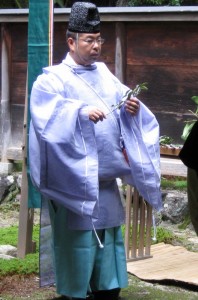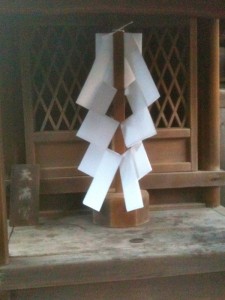
Offerings for the dead, as for kami, may include favourite food or drink alongside water, saké, salt and rice grains.
Funeral ceremony
The funeral proper is but one in a series of rites for the deceased. Usually held two days after the death, it takes about two hours. Since a Shinto funeral cannot be held on shrine grounds (due to the impurity of death), it is conducted in a private house, a commercial funeral hall, a community center, or in a shrine-owned building adjacent to but not actually part of the shrine precincts.
The coffin is the basis of the altar. Arranged around the coffin are: a photo of the deceased; a banner with the name of the deceased; a protective sword or a mirror; a pair of black lacquered clogs placed on a table near the head of the deceased. Tables of food offerings (favorite foods of the deceased, salt, water, rice, vegetables, fruit, sweets) are also set up.
This coffin-altar is set up against the back of the room. Shimenawa (sacred rope) or curtains may be hung around the area, white and yellow banners stand near the coffin, while lights and sakaki branches are placed in front. The ritual area has usually been raised up higher than the floor on which the mourners sit. If it is not higher, it is marked off in some way from the other part of the room.
Shinto funerals naturally vary according to the local shrine customs, the status or personality of the deceased, and the influence of folk tradition. An outline of a typical funeral is as follows:
1 . The mourners purify themselves by washing their hands and mouths.
2. The mourners enter the funeral site and take their seats. If there are musicians (who are usually Shinto priests themselves), they enter the room after the mourners.
3. The chief priest enters the room. The participants bow once in unison toward the priest.
4. Announcement of the start of the funeral: “We will now hold the funeral of So-and-So.”
5. Purification rite. The priests purify the room, offerings and participants. The participants make a deep bow while the priest performs the purification. If they are sitting on chairs, they should stand up and bow their heads.
6. The chief priest bows once, and others follow.
7. The priests present the food offerings and banners; gagaku music may be played, live or taped. In a 1995 funeral for a Shinto priest in Shiga prefecture, the offerings were more varied than the ritual manuals would indicate: sake, large flat rice cakes, fish, seaweed, radish, cabbage, carrots, bananas, melons, and apples.
8. The priests offer gohei (wood sticks with zigzag white paper attached; also called heihaku).
9. The chief priest presents an elegy praising the life of the deceased and prays that the deceased may rest in peace and become a guardian deity, like his own ancestors, to watch over his descendants. The mourners listen to the priest’s words with bowed heads.
10. A eulogy is offered by an assistant priest. He gives a brief biography and describes the virtues of the deceased.
1 1 . Expressions of condolence by the mourners.
12. Reading of condolence telegrams and other messages.
13. Offering of tamagushi. First the chief priest presents a tamagushi to the altar, then the other priests do so. Next, the chief mourner, family members and other guests offer tamagushi.
13. The priests remove first the gohei, then the food offerings.
14. The chief priest bows once. Then the mourners all bow once.
15. The priests leave the room.
16. Announcement of the end of the funeral.

Tamagushi are a common offering in Shinto, for both kami and the deceased
Throughout the funeral, when the priests or others are called upon to clap, they should clap without making any noise. This is called shinobide (literally, patient hands). Ordinary clapping is a regular part of Shinto worship. The soundless clapping at funerals thus represents an inversion of normal practices. Some priests state that silent clapping should be practiced for one year after the funeral during the memorial rites. Others state that the clapping should gradually get louder and louder over the course of a year.
The 1995 funeral in Shiga for a Shinto priest included an additional eulogy by the chief mourner, the son of the deceased, himself also now a Shinto priest after a twenty-year business career. Toward the end of the ceremony, he stepped out of the building to address the many people standing outside who had listened to the ceremony over loudspeakers.
The priest thanked them for coming on such a cold day and spoke of his father with respect and affection. He used ordinary Japanese, not the high stilted voice and archaic diction he had used in front of the altar when delivering a eulogy directly to the deceased. One guest commented with approval that he sounded “like a real pro” (that is, a professional Shinto priest) inside, but outside he sounded “like a son.”
Next, gifts were distributed to the mourners. The gifts, contained in ordinary white supermarket plastic bags, were distributed unceremoniously from the back of a truck. As the guests waited for the funeral procession to begin, some of them looked inside the bags and took out small sweets and crackers.

Gagaku music may be played live or recorded during the funeral


Leave a Reply